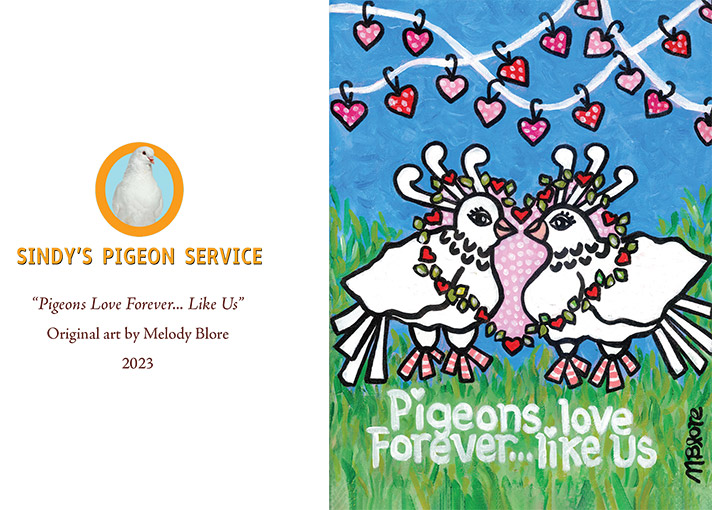Valentine’s Day cannot come and go without a word about the ubiquitous symbol for the day – the white pigeon or dove. In English, the word “dove” and “pigeon” are largely interchangeable, but the doves we see at our feeders (mourning doves and Eurasian collar doves) are not white, nor are they particularly faithful to their mates. Pigeons, on the other hand, mate for life, co-parent equally and love their mate until death and beyond. Early human beings worshipped pigeons for this loyalty to their mates and for their fertility. As such, the white pigeon became a symbol for many early goddesses: the Mesopotamian goddess, Inanna, the Canaanite goddesses, Asherah and Astarte, and the Greek goddess, Aphrodite. Inanna, Asherah and Astarte are all represented holding a resting bird (that looks like a pigeon) on their hand. Aphrodite, the goddess of love (known in Roman mythology as Venus) is often seen pulled by her chariot drawn by white doves (again, that look exactly like white homing pigeons).
How pigeons and doves became associated with Valentine’s Day is guesswork, but this is a plausible theory. Valentine’s Day itself came into being as a holiday sometime in the Middle Ages. It was thought to have been created by the Catholic Church to celebrate Saint Valentine. The day chosen by the Church for Saint Valentine’s celebration was February 14th. It was also during the Middle ages that the practice of ornithomancy gained credibility. Ornithomancy is the practice of interpreting the sighting of certain birds as a sign of someone’s future. Ornithomancy had been around since ancient times, when Greeks and Romans believed that certain birds were omens. Undoubtedly, European common folk also had similar lore in Medieval times. It wasn’t until the 1200’s, that Holy Roman Emperor Frederick II wrote a book, called “The Art of Falconry.” Frederick II was a highly educated ruler, speaking six languages. He also was a falconer. In his book, there is a lengthy introduction dealing with the anatomy of birds, an interesting description of avian habits, and the excursions of migratory birds. This ancient book is still recognized as the first zoological treatise written in the critical spirit of modern science. It also discussed ornithomancy, the practice of interpreting the sighting of certain birds as a way to glimpse into someone’s future.
Geffrey Chaucer, an English poet and author of the famous Canterbury Tales is credited with tying Valentine’s Day to the subject of birds and love in his poem, The Parliament of Foules:
For this day was sent on Valentine’s Day when every fowl is there to choose his mate. Here in nature is convening a parliament at which birds will all choose their mates. The three male eagles make their case for the hand of the female eagle until the birds of the lower estates begin to protest and launch into a comic parliamentary debate which nature to herself, finally ends.
Chaucer was apparently writing a critique about the engagement of King Richard II to Anne of Bohemia. Regardless of its purpose, Chaucer was likely the first person to link Valentine’s Day with love and birds and the practice of ornithomancy.
So, on Valentine’s Day, ornithomancy foretold that these bird species would symbolize a future relationship with the following types of individuals:
- Blackbirds: a person of the cloth or a priest. Blackbirds also symbolize a kind person because their black glossy plumage reflects spirituality and charity.
- Bluebirds: a person with a sense of humor, perhaps a comedian.
- Crossbills: a person of argument, such as a lawyer. Not someone you want to “cross”.
- Pigeons/doves: a kind and loyal, peaceful person and a lifelong, happy partnership.
- Goldfinches, Yellowhammers, Yellow Wagtails, Yellow Warbler: a person of riches because of the birds’ gold plumage which symbolizes wealth.
- Robins: seafarers.
- Sparrows: country folks or naturalists.
- Woodpeckers: no relationship that year.
- Nuthatches: a person of knowledge. They are very clever, intellectual birds with their upside-down foraging techniques.
- Swans: a person of creativity, whether it be music, visual arts, dance, or theater.
- Canaries: a person of healing. Like the adage of a “canary in a coal mine”, they can often predict when things are in need of healing. These might be doctors or masseuses for example.
- Turkeys: naturalists and environmentalists. Seeing a turkey might even mean you’ll be courting with another birder!
- Birds of Prey: a person in positions of power or leadership. Eagles as an example, also mate for life, so when an eagle is seen it means you are bound to have a stable, life-long relationship.
- Canada Geese: a family man or woman, or someone who is very caring. Canada Geese are lifelong partners and symbolize life-long relationships. Geese are also often caring, helping their young or other injured geese, often staying behind when necessary to aid those injured.
Today in America, Valentine’s Day is little more than a Hallmark holiday. It has lost its religious significance and its “fortune telling” properties. But, I suggest, that on February 14th, singles go to a city and feed the pigeons or a local field or golf course where the Canadian geese are hanging out. While it may not be prognosticating your future, you will certainly learn something about the special love that bonds these birds. And, if anyone wants to wish a friend or family member a loyal and happy marriage, you might send a pigeon card (from sindyspigeonservice.com, not Hallmark), so that it will be the first bird your loved one sees on Valentine’s Day!
